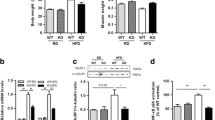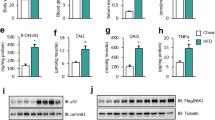Abstract
Aims
Inflammation induced by hyperglycemia triggers the toll-like receptor (TLR) pathway into cells. Our hypothesis was that metformin treatment attenuates the TLR signaling pathways triggered by inflammation in skeletal muscle of hypoinsulinemic/hyperglycemic STZ-induced rats. Thus, we examined TLR signaling under hypoinsulinemia and hyperglycemia conditions and its correlation with insulin resistance in muscle of diabetic rats treated with metformin.
Methods
Ten-day diabetic rats were submitted to 7 days of saline (D group) or metformin (500 mg/kg once per day) (D + M group). The skeletal muscle was collected before the insulin tolerance test. Then, Western blotting analysis of skeletal muscle supernatant was probed with TLR4, TLR2, NF-κB, IκB, p-AMPK and p-JNK. TNF-α and CXCL1/KC content was analyzed by ELISA.
Results
Metformin treatment increased whole-body insulin sensitivity. This regulation was accompanied by a parallel change of p-AMPK and by an inverse regulation of TLR4 and NF-κB contents in the soleus muscle (r = 0.7229, r = −0.8344 and r = −0.7289, respectively, Pearson correlation; p < 0.05). Metformin treatment increased IκB content when compared to D rats. In addition, metformin treatment decreased p-JNK independently of TLR2 signal in diabetic rats.
Conclusion
In summary, the results indicate a relationship between muscular TLR4, p-AMPK and NF-κB content and insulin sensitivity. The study also highlights that in situations of insulin resistance, such as in diabetic subjects, metformin treatment may prevent attenuation of activation of the inflammatory pathway.



Similar content being viewed by others
References
Hotamisligil GS (2006) Inflammation and metabolic disorders. Nature 444:860–867
Pickup JC (2004) Inflammation and activated innate immunity in the pathogenesis of type 2 diabetes. Diabetes Care 27:813–823
Plomgaard P, Bouzakri K, Krogh-Madsen R, Mittendorfer B, Zierath JR, Pedersen BK (2005) Tumor necrosis factor-alpha induces skeletal muscle insulin resistance in healthy human subjects via inhibition of Akt substrate 160 phosphorylation. Diabetes 54:2939–2945
Kim JJ, Sears DD (2010) TLR4 and insulin resistance. Gastroenterol Res Pract 2010:1–11, Art ID 212563. doi:10.1155/2010/212563
Galbo T, Perry RJ, Jurczak MJ, Camporez JP, Alves TC, Kahn M et al (2013) Saturated and unsaturated fat induce hepatic insulin resistance independently of TLR-4 signaling and ceramide synthesis in vivo. Proc Natl Acad Sci USA 110:12780–12785
Devaraj S, Jialal I, Yun JM, Bremer A (2011) Demonstration of increased toll-like receptor 2 and toll-like receptor 4 expression in monocytes of type 1 diabetes mellitus patients with microvascular complications. Metabolism 60:256–259
Zipris D (2010) Toll-like receptors and type 1 diabetes. Adv Exp Med Biol 654:585–610
Devaraj S, Dasu MR, Rockwood J, Winter W, Griffen SC, Jialal I (2008) Increased toll-like receptor (TLR) 2 and TLR4 expression in monocytes from patients with type 1 diabetes: further evidence of a proinflammatory state. J Clin Endocrinol Metab 93:578–583
Reyna SM, Ghosh S, Tantiwong P, Meka CS, Eagan P, Jenkinson CP et al (2008) Elevated toll-like receptor 4 expression and signaling in muscle from insulin-resistant subjects. Diabetes. 57:2595–2602
Takeuchi O, Akira S (2001) Toll-like receptors; their physiological role and signal transduction system. Int Immunopharmacol 1:625–635
Lin HY, Tang CH, Chen JH, Chuang JY, Huang SM, Tan TW et al (2011) Peptidoglycan induces interleukin-6 expression through the TLR2 receptor, JNK, c-Jun, and AP-1 pathways in microglia. J Cell Physiol 226:1573–1582
Wang H, Wu Y, Ojcius DM, Yang XF, Zhang C, Ding S et al (2012) Leptospiral hemolysins induce proinflammatory cytokines through Toll-like receptor 2-and 4-mediated JNK and NF-kappaB signaling pathways. PLoS ONE 7:e42266
Akira S, Takeda K (2004) Toll-like receptor signalling. Nat Rev Immunol 4:499–511
Barnes PJ, Karin M (1997) Nuclear factor-kappaB: a pivotal transcription factor in chronic inflammatory diseases. N Engl J Med 336:1066–1071
Baker RG, Hayden MS, Ghosh S (2011) NF-kappaB, inflammation, and metabolic disease. Cell Metab 13:11–22
Boyd JH, Divangahi M, Yahiaoui L, Gvozdic D, Qureshi S, Petrof BJ (2006) Toll-like receptors differentially regulate CC and CXC chemokines in skeletal muscle via NF-kappaB and calcineurin. Infect Immun 74:6829–6838
Nedachi T, Hatakeyama H, Kono T, Sato M, Kanzaki M (2009) Characterization of contraction-inducible CXC chemokines and their roles in C2C12 myocytes. Am J Physiol Endocrinol Metab 297:E866–E878
Poletto AC, Furuya DT, David-Silva A, Ebersbach-Silva P, Santos CL, Correa-Giannella ML et al (2015) Oleic and linoleic fatty acids downregulate Slc2a4/GLUT4 expression via NFKB and SREBP1 in skeletal muscle cells. Mol Cell Endocrinol 401:65–72
Konner AC, Bruning JC (2011) Toll-like receptors: linking inflammation to metabolism. Trends Endocrinol Metab 22:16–23
Okamoto MM, Anhe GF, Sabino-Silva R, Marques MF, Freitas HS, Mori RC et al (2011) Intensive insulin treatment induces insulin resistance in diabetic rats by impairing glucose metabolism-related mechanisms in muscle and liver. J Endocrinol 211:55–64
de Laat MA, Gruntmeir KJ, Pollitt CC, McGowan CM, Sillence MN, Lacombe VA (2014) Hyperinsulinemia down-regulates TLR4 expression in the mammalian heart. Front Endocrinol (Lausanne) 5:120
Boucher J, Kleinridders A, Kahn CR (2014) Insulin receptor signaling in normal and insulin-resistant states. Cold Spring Harb Perspect Biol 6:a009191. doi:10.1101/cshperspect.a009191
Kristensen JM, Treebak JT, Schjerling P, Goodyear L, Wojtaszewski JF (2014) Two weeks of metformin treatment induces AMPK-dependent enhancement of insulin-stimulated glucose uptake in mouse soleus muscle. Am J Physiol Endocrinol Metab 306:E1099–E1109
Saisho Y (2015) Metformin and inflammation: its potential beyond glucose-lowering effect. Endocr Metab Immune Disord Drug Targets 15:196–205
Strack T (2008) Metformin: a review. Drugs Today (Barc) 44:303–314
Oshima R, Yamada M, Kurogi E, Ogino Y, Serizawa Y, Tsuda S et al (2015) Evidence for organic cation transporter-mediated metformin transport and 5′-adenosine monophosphate-activated protein kinase activation in rat skeletal muscles. Metabolism 64:296–304
Soraya H, Farajnia S, Khani S, Rameshrad M, Khorrami A, Banani A et al (2012) Short-term treatment with metformin suppresses toll like receptors (TLRs) activity in isoproterenol-induced myocardial infarction in rat: are AMPK and TLRs connected? Int Immunopharmacol 14:785–791
Soraya H, Clanachan AS, Rameshrad M, Maleki-Dizaji N, Ghazi-Khansari M, Garjani A (2014) Chronic treatment with metformin suppresses toll-like receptor 4 signaling and attenuates left ventricular dysfunction following myocardial infarction. Eur J Pharmacol 737:77–84
Hirsch HA, Iliopoulos D, Struhl K (2013) Metformin inhibits the inflammatory response associated with cellular transformation and cancer stem cell growth. Proc Natl Acad Sci USA 110:972–977
Huang NL, Chiang SH, Hsueh CH, Liang YJ, Chen YJ, Lai LP (2009) Metformin inhibits TNF-alpha-induced IkappaB kinase phosphorylation, IkappaB-alpha degradation and IL-6 production in endothelial cells through PI3 K-dependent AMPK phosphorylation. Int J Cardiol 134:169–175
Steinberg GR, Michell BJ, van Denderen BJ, Watt MJ, Carey AL, Fam BC et al (2006) Tumor necrosis factor alpha-induced skeletal muscle insulin resistance involves suppression of AMP-kinase signaling. Cell Metab 4:465–474
Bradford MM (1976) A rapid and sensitive method for the quantitation of microgram quantities of protein utilizing the principle of protein-dye binding. Anal Biochem 72:248–254
Laemmli UK, Favre M (1973) Maturation of the head of bacteriophage T4. I. DNA packaging events. J Mol Biol 80:575–599
Towbin H, Staehelin T, Gordon J (1992) Electrophoretic transfer of proteins from polyacrylamide gels to nitrocellulose sheets: procedure and some applications. 1979. Biotechnology 24:145–149
Chen L, Chen R, Wang H, Liang F (2015) Mechanisms Linking Inflammation to Insulin Resistance. Int J Endocrinol 2015:508409
Hutton MJ, Soukhatcheva G, Johnson JD, Verchere CB (2010) Role of the TLR signaling molecule TRIF in beta-cell function and glucose homeostasis. Islets 2:104–111
Hattori Y, Suzuki K, Hattori S, Kasai K (2006) Metformin inhibits cytokine-induced nuclear factor kappaB activation via AMP-activated protein kinase activation in vascular endothelial cells. Hypertension 47:1183–1188
Takeda K, Kaisho T, Akira S (2003) Toll-like receptors. Annu Rev Immunol 21:335–376
Dasu MR, Devaraj S, Park S, Jialal I (2010) Increased toll-like receptor (TLR) activation and TLR ligands in recently diagnosed type 2 diabetic subjects. Diabetes Care 33:861–868
Cejkova P, Nemeckova I, Broz J, Cerna M (2015) TLR2 and TLR4 expression on CD14 and CD14 monocyte subtypes in adult-onset autoimmune diabetes. Biomed Pap Med Fac Univ Palacky Olomouc Czech Repub 160:76. doi:10.5507/bp.2015.016.17
Gu J, Ye S, Wang S, Sun W, Hu Y (2014) Metformin inhibits nuclear factor-kappaB activation and inflammatory cytokines expression induced by high glucose via adenosine monophosphate-activated protein kinase activation in rat glomerular mesangial cells in vitro. Chin Med J (Engl) 127:1755–1760
Giannarelli R, Aragona M, Coppelli A, Del Prato S (2003) Reducing insulin resistance with metformin: the evidence today. Diabetes Metab 29:6S28–6S35
Wang Z, Cheng Z, Cristofaro V, Li J, Xiao X, Gomez P et al (2012) Inhibition of TNF-alpha improves the bladder dysfunction that is associated with type 2 diabetes. Diabetes 61:2134–2145
Gupta S, Bi R, Kim C, Chiplunkar S, Yel L, Gollapudi S (2005) Role of NF-kappaB signaling pathway in increased tumor necrosis factor-alpha-induced apoptosis of lymphocytes in aged humans. Cell Death Differ 12:177–183
Luster AD (1998) Chemokines–chemotactic cytokines that mediate inflammation. N Engl J Med 338:436–445
Vieira SM, Lemos HP, Grespan R, Napimoga MH, Dal-Secco D, Freitas A et al (2009) A crucial role for TNF-alpha in mediating neutrophil influx induced by endogenously generated or exogenous chemokines, KC/CXCL1 and LIX/CXCL5. Br J Pharmacol 158:779–789
Ehses JA, Lacraz G, Giroix MH, Schmidlin F, Coulaud J, Kassis N et al (2009) IL-1 antagonism reduces hyperglycemia and tissue inflammation in the type 2 diabetic GK rat. Proc Natl Acad Sci USA 106:13998–14003
Li J, Deng J, Sheng W, Zuo Z (2012) Metformin attenuates Alzheimer’s disease-like neuropathology in obese, leptin-resistant mice. Pharmacol Biochem Behav 101:564–574
Lin W, Ding M, Xue J, Leng W (2013) The role of TLR2/JNK/NF-kappaB pathway in amyloid beta peptide-induced inflammatory response in mouse NG108-15 neural cells. Int Immunopharmacol 17:880–884
Davies C, Tournier C (2012) Exploring the function of the JNK (c-Jun N-terminal kinase) signalling pathway in physiological and pathological processes to design novel therapeutic strategies. Biochem Soc Trans 40:85–89
Deng Y, Ren X, Yang L, Lin Y, Wu X (2003) A JNK-dependent pathway is required for TNFalpha-induced apoptosis. Cell 115:61–70
Moller DE (2000) Potential role of TNF-alpha in the pathogenesis of insulin resistance and type 2 diabetes. Trends Endocrinol Metab 11:212–217
Aguirre V, Uchida T, Yenush L, Davis R, White MF (2000) The c-Jun NH(2)-terminal kinase promotes insulin resistance during association with insulin receptor substrate-1 and phosphorylation of Ser(307). J Biol Chem 275:9047–9054
Hirosumi J, Tuncman G, Chang L, Gorgun CZ, Uysal KT, Maeda K et al (2002) A central role for JNK in obesity and insulin resistance. Nature 420:333–336
Werner ED, Lee J, Hansen L, Yuan M, Shoelson SE (2004) Insulin resistance due to phosphorylation of insulin receptor substrate-1 at serine 302. J Biol Chem 279:35298–35305
Acknowledgements
The authors thank the Fundação de Amparo à Pesquisa do Estado de Minas Gerais—FAPEMIG for its support. L.G.P., D.D.V., and L.N.B. were recipients of Conselho Nacional de Desenvolvimento Científico e Tecnológico—CNPq, Coordenação de Aperfeiçoamento de Pessoal de Nível Superior—CAPES and FAPEMIG fellowships. F.S.E. is a grant recipient of CNPq.
Author information
Authors and Affiliations
Contributions
LGP, RRT, RSS and FSE conceived and designed the experiments. LGP, RRT, DDV, LNB, SRD and FAA performed the experiments. LGP, RRT, DDV, FAA, RSS and FSE analyzed the data. LGP, LNB, RRT and RSS wrote the paper. FSE supervised the entire project.
Corresponding author
Ethics declarations
Conflict of interest
The authors declare that they have no conflict of interest.
Ethical standard
This article does not contain any study with human. All procedures performed in this study involving animals were in accordance with the ethical standards of Ethics Committee of Federal University of Uberlândia.
Informed consent
None.
Additional information
Managed by Antonio Secchi.
Electronic supplementary material
Below is the link to the electronic supplementary material.
Rights and permissions
About this article
Cite this article
Peixoto, L.G., Teixeira, R.R., Vilela, D.D. et al. Metformin attenuates the TLR4 inflammatory pathway in skeletal muscle of diabetic rats. Acta Diabetol 54, 943–951 (2017). https://doi.org/10.1007/s00592-017-1027-5
Received:
Accepted:
Published:
Issue Date:
DOI: https://doi.org/10.1007/s00592-017-1027-5




